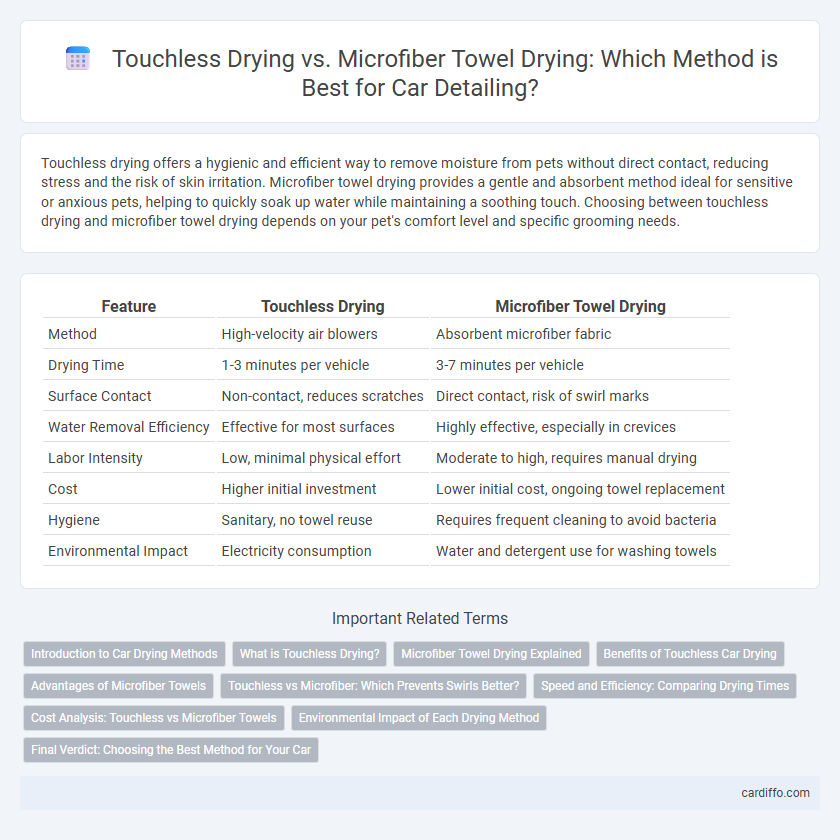Touchless drying offers a hygienic and efficient way to remove moisture from pets without direct contact, reducing stress and the risk of skin irritation. Microfiber towel drying provides a gentle and absorbent method ideal for sensitive or anxious pets, helping to quickly soak up water while maintaining a soothing touch. Choosing between touchless drying and microfiber towel drying depends on your pet's comfort level and specific grooming needs.
Table of Comparison
| Feature | Touchless Drying | Microfiber Towel Drying |
|---|---|---|
| Method | High-velocity air blowers | Absorbent microfiber fabric |
| Drying Time | 1-3 minutes per vehicle | 3-7 minutes per vehicle |
| Surface Contact | Non-contact, reduces scratches | Direct contact, risk of swirl marks |
| Water Removal Efficiency | Effective for most surfaces | Highly effective, especially in crevices |
| Labor Intensity | Low, minimal physical effort | Moderate to high, requires manual drying |
| Cost | Higher initial investment | Lower initial cost, ongoing towel replacement |
| Hygiene | Sanitary, no towel reuse | Requires frequent cleaning to avoid bacteria |
| Environmental Impact | Electricity consumption | Water and detergent use for washing towels |
Introduction to Car Drying Methods
Touchless drying uses powerful air blowers to remove water from a vehicle's surface, minimizing contact and reducing the risk of scratches or swirl marks. Microfiber towel drying involves gently wiping the car with soft, highly absorbent towels designed to trap moisture and contaminants without damaging the paint. Both methods aim to prevent water spots and enhance the vehicle's finish, with industry professionals selecting techniques based on the level of care and efficiency desired.
What is Touchless Drying?
Touchless drying uses powerful air blowers to remove water from a vehicle's surface without physical contact, minimizing the risk of scratches and swirl marks. This method enhances efficiency and reduces the potential for introducing contaminants that microfiber towels might carry. By relying on high-velocity air streams, touchless drying preserves the vehicle's paint integrity and delivers a spotless finish.
Microfiber Towel Drying Explained
Microfiber towel drying uses ultra-fine synthetic fibers designed to absorb water efficiently while minimizing the risk of scratches or swirl marks on the vehicle's paint surface. This method provides controlled drying that quickly removes moisture from intricate areas like crevices and seams, ensuring a spotless, streak-free finish. Unlike touchless drying systems that rely on airflow, microfiber towels offer gentle contact, which helps maintain the vehicle's finish and reduces water spotting on delicate surfaces.
Benefits of Touchless Car Drying
Touchless car drying eliminates the risk of swirl marks and scratches caused by microfiber towels, preserving the paint's integrity and shine. It offers a faster, more hygienic drying process by utilizing powerful air blowers to remove water without physical contact. This method enhances efficiency and reduces labor time, making it ideal for professional detailing and high-volume car care operations.
Advantages of Microfiber Towels
Microfiber towels excel in absorbing water efficiently, reducing the risk of water spots and streaks on vehicle surfaces after washing. Their soft, non-abrasive fibers prevent scratches and swirl marks, ensuring paint protection during the drying process. Compared to touchless drying systems, microfiber towels offer greater control over drying, enhancing the overall finish and detail quality.
Touchless vs Microfiber: Which Prevents Swirls Better?
Touchless drying systems use high-velocity air to remove water without physical contact, reducing the risk of swirls caused by microfiber towels dragging contaminants across the paint surface. Microfiber towels effectively absorb water and provide control but can trap dirt particles that cause micro-scratches and swirl marks if not used properly. For swirl prevention, touchless drying offers a superior method by eliminating contact and minimizing mechanical abrasion on automotive paint finishes.
Speed and Efficiency: Comparing Drying Times
Touchless drying systems significantly reduce vehicle drying time by using high-velocity air jets that quickly remove water from surfaces, often completing the process in under two minutes. Microfiber towel drying, while effective in preventing water spots and streaks, requires more manual effort and typically takes three to five minutes per vehicle depending on size and surface complexity. The efficiency of touchless drying is especially advantageous in high-volume detailing environments where speed is critical to maintaining workflow and customer satisfaction.
Cost Analysis: Touchless vs Microfiber Towels
Touchless drying systems require a higher initial investment compared to microfiber towels, with costs ranging from $1,500 to $5,000 per unit versus $5 to $15 per towel. Operational expenses for touchless dryers include electricity consumption, estimated at $0.10 to $0.20 per cycle, while microfiber towels incur ongoing costs related to laundering, averaging $0.50 per towel per use. Over time, microfiber towels may provide cost savings for smaller detailing businesses due to lower upfront costs, whereas touchless dryers offer efficiency benefits that can justify higher expenses in high-volume operations.
Environmental Impact of Each Drying Method
Touchless drying systems consume significantly less water and reduce chemical runoff compared to microfiber towel drying, which often requires frequent washing that generates microplastic pollution and high water usage. Microfiber towels contribute to environmental waste as they shed microfibers during laundering, contaminating waterways with synthetic fibers harmful to aquatic life. Choosing touchless drying minimizes ecological footprint by lowering water consumption and preventing microfiber pollution, promoting a more sustainable car detailing process.
Final Verdict: Choosing the Best Method for Your Car
Touchless drying systems reduce the risk of scratches and swirls by eliminating direct contact with the car's surface, making them ideal for maintaining delicate paint finishes. Microfiber towel drying offers superior water absorption and speed, allowing for more thorough drying and minimizing water spotting on vehicles with textured surfaces. Choosing the best drying method depends on your car's paint type, finish sensitivity, and personal preference for speed versus surface protection.
Touchless Drying vs Microfiber Towel Drying Infographic

 cardiffo.com
cardiffo.com